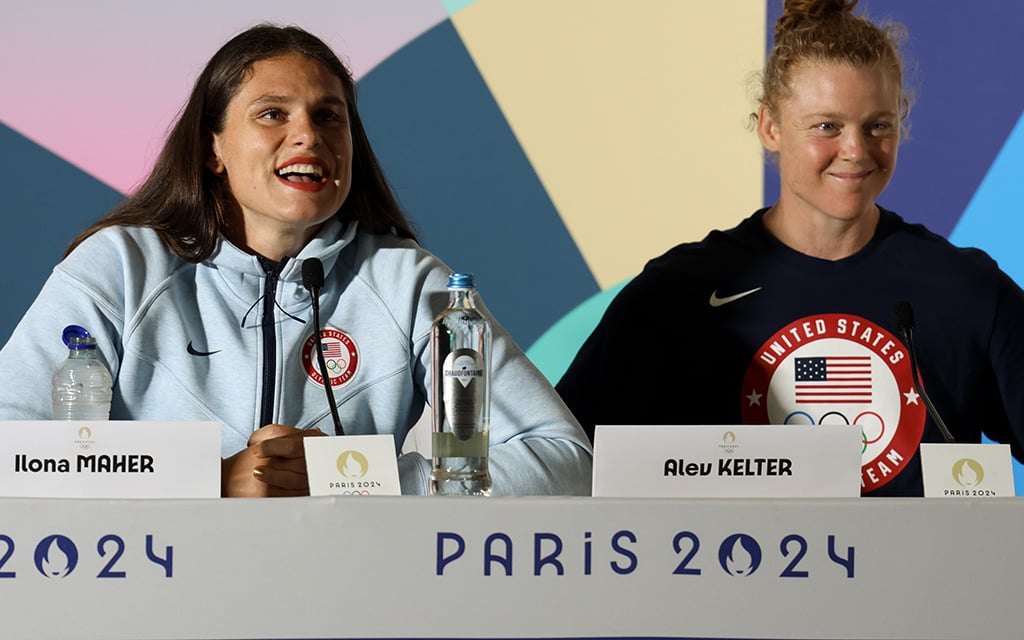PARIS – From fans attacking rugby standout Ilona Maher for her BMI to others questioning gymnast Simone Biles about her “just rolled out of bed” hair, social media has surfaced as a significant storyline at the Paris Games. It is the dark side of a tool that also serves as a powerful marketing tool for many Olympians.
Ilona Maher, the star of the USA Women’s Rugby Sevens team, just became the most followed rugby player in the world following the team’s breakout performance at the Olympics. This week the bronze medalist became the first women’s rugby player to surpass one million Instagram followers and now boasts two million followers. With this meteoric rise in following came the hateful messages athletes, especially women athletes, receive in regards to their bodies.
In a recent TikTok post she responded to a comment making fun of her saying, “I bet that person has a 30% BMI.” Maher revealed that that’s technically not true (it’s 29.3) while pointing out BMI is an estimator of body fat percentage using height and weight. For athletes, their readings can be incredibly misleading because of how much muscle they have. While her BMI would say she’s borderline obese, one look at her suggests an extremely fit person.
“I definitely get a lot of trolls online, and get a lot of mean comments,” Maher said. “It kind of comes with the gig, I guess. It’s comments I think a lot of female athletes get about being masculine because you play a sport, being manly, all sorts of mean things like that. It’s so crazy because I’ll get 20,000 great comments and then one (negative comment) from some dude in Idaho.”
Because of this, she uses her platforms on Instagram and TikTok to promote body positivity and the inclusion of women in sports.
“I’m a female athlete in a sport that, especially in America, it’s not very big, it’s not a money-making sport,” Maher said. “So for me, it was important to make this a career. I don’t think many women can think that way. I didn’t go into college thinking I could be a professional athlete. I went to college to be a nurse because it didn’t seem plausible to do athletics. I’m not going to get millions going to the NFL or NBA, so I don’t think many girls can dream of being a professional athlete and making it a career.”
Simone Biles, who captured gold with Team USA gymnasts Tuesday, found herself responding to social media attacks on her appearance while preparing for competition.
“Don’t come for me about my hair. IT WAS DONE but bus has NO AC & it’s like 9,0000 degrees,” she wrote over an Instagram video while traveling on a bus. “Oh & a 45 min ride.”
For many Olympians, however, social media can complement their careers.
Long jumper Tara Davis-Woodhall and shot putter Ryan Crouser may look like polar opposites, but outside of being multi-time Olympic athletes they share something else in common: They both have expanded their respective disciplines’ reach through their social media followings.
Davis-Woodhall shares a blog-style YouTube channel with her husband and Paralympic athlete Hunter Woodhall where the two have nearly 800,000 subscribers. The two have shared their channel, aptly named Tara and Hunter, since 2017.
“I have people that follow me not because I run track. They follow me because they enjoy my content,” Davis-Woodhall said.
Tara and Hunter upload videos about once a week which typically include their travels for competition, training together and their day-to-day life.
“They enjoy what Hunter and I do together,” Woodhall-Davis said. “It’s cool, because I get to have both sides, where I get to show my lifestyle, but I also get to show my sport, and we get to grow the sport in that way.”
Sprinters secure much of the fame associated with track and field in part due to their sheer speed, so having attention on less popular disciplines like the long jump and Paralympic athletics by way of their vlogs has brought in new fans from all over the world.
“As a long jumper, we don’t get that many views, so I do everything in my power to bring eyes to the sport,” Davis-Woodhall said.
As for Crouser, he doesn’t appear to be all-consumed by social media. If anything, he’s all-consumed by his quest for a third straight gold medal. Crouser doesn’t share the same level of internet fame as Davis-Woodhall, but his social media channels have helped cement him as one of the most recognizable shot putters, if not the most recognizable shot putter in the world.
The social media attention just happens to be a product of his world-class performance. His YouTube channel features shot put tips, workout tutorials, Q & A’s and the occasional blog video. The social media attention just happens to be a product of his world-class performance
“I remember 2016, it’s a while ago, but I hit 10k followers (on Instagram), and at the time, as a shot putter, that seemed like a huge deal,” Crouser said, who now has nearly 150,000 Instagram followers. “We are the cutting edge of human performance, whether it’s jumping far, throwing far, sprinting, fast, social media is a great way to show that.”
When watching the Games, it can be easy for some to sit on the couch with chip crumbs on their stomach and call the people who finish at the bottom of their competitions “losers.” Social media allows athletes a chance to respond to those “losers” and also provides a platform to show off how good their fellow competitors really are.
“When you have the eight fastest people in the world in a race, the slow person is still the eighth fastest person in the world,” Crouser said. “In reality, you’re still the eighth fastest, eighth, strongest, eighth best jumper, whatever it might be. So social media is a great way for us to convey what makes our sports special. We are the peak of performance.”
Social media has become so ingrained within the fabric of society and culture that it’s nearly impossible to live a modern life without it. Many use it to keep up with friends, waste time, post silly things or otherwise waste time.
Beyond that, it can be a tool for change, a tool to amplify voices and a tool to bring people together.


